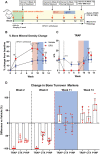Temporal patterns of osteoclast formation and activity following withdrawal of RANKL inhibition
- PMID: 38477789
- PMCID: PMC11262142
- DOI: 10.1093/jbmr/zjae023
Temporal patterns of osteoclast formation and activity following withdrawal of RANKL inhibition
Abstract
Rebound bone loss following denosumab discontinuation is an important clinical challenge. Current treatment strategies to prevent this fail to suppress the rise and overshoot in osteoclast-mediated bone resorption. In this study, we use a murine model of denosumab treatment and discontinuation to show the temporal changes in osteoclast formation and activity during RANKL inhibition and withdrawal. We show that the cellular processes that drive the formation of osteoclasts and subsequent bone resorption following withdrawal of RANKL inhibition precede the rebound bone loss. Furthermore, a rise in serum TRAP and RANKL levels is detected before markers of bone turnover used in current clinical practice. These mechanistic advances may provide insight into a more defined window of opportunity to intervene with sequential therapy following denosumab discontinuation.
Keywords: Denosumab; RANKL; osteoclast; osteoporosis.
Plain language summary
Stopping denosumab, a medication commonly used to improve bone mass by blocking formation of bone resorbing osteoclasts, leads to a rebound loss in the bone which was gained during treatment. Current strategies to prevent this bone loss fail in most cases as they are unable to prevent the rise and overshoot in bone resorption by osteoclasts. Thie stems from an incomplete understanding of how osteoclasts behave during denosumab treatment and after treatment is discontinued. We use a mouse model of this phenomenon to show how osteoclast formation and activity changes throughout this process. We show that increases in the processes that drive the formation of osteoclasts can be detected in the circulation before bone loss occurs. These findings could therefore provide insight into a targeted ‘window of opportunity’ to intervene and prevent the rebound bone loss following stopping denosumab in patients.
© The Author(s) 2024. Published by Oxford University Press on behalf of the American Society for Bone and Mineral Research.
Conflict of interest statement
None declared.
Figures






Similar articles
-
Early and multiple doses of zoledronate mitigates rebound bone loss following withdrawal of receptor activator of nuclear factor kappa-B ligand inhibition.J Bone Miner Res. 2025 Mar 15;40(3):413-427. doi: 10.1093/jbmr/zjaf008. J Bone Miner Res. 2025. PMID: 39846954 Free PMC article.
-
Mouse model of anti-RANKL discontinuation reveals reduced bone mass and quality through disruption of bone remodeling.Bone Res. 2025 May 28;13(1):56. doi: 10.1038/s41413-025-00433-0. Bone Res. 2025. PMID: 40425548 Free PMC article.
-
Osteoclast Recycling and the Rebound Phenomenon Following Denosumab Discontinuation.Curr Osteoporos Rep. 2022 Dec;20(6):505-515. doi: 10.1007/s11914-022-00756-5. Epub 2022 Oct 6. Curr Osteoporos Rep. 2022. PMID: 36201122 Free PMC article. Review.
-
Changes in RANKL and TRAcP 5b after discontinuation of denosumab suggest RANKL mediated formation of osteoclasts results in the increased bone resorption.Osteoporos Int. 2023 Mar;34(3):599-605. doi: 10.1007/s00198-022-06651-0. Epub 2022 Dec 22. Osteoporos Int. 2023. PMID: 36543965 Clinical Trial.
-
Role of RANK ligand and denosumab, a targeted RANK ligand inhibitor, in bone health and osteoporosis: a review of preclinical and clinical data.Clin Ther. 2012 Mar;34(3):521-36. doi: 10.1016/j.clinthera.2012.02.002. Clin Ther. 2012. PMID: 22440513 Review.
Cited by
-
Early and multiple doses of zoledronate mitigates rebound bone loss following withdrawal of receptor activator of nuclear factor kappa-B ligand inhibition.J Bone Miner Res. 2025 Mar 15;40(3):413-427. doi: 10.1093/jbmr/zjaf008. J Bone Miner Res. 2025. PMID: 39846954 Free PMC article.
-
Uncemented hip arthroplasty and denosumab: increased postoperative dipeptide concentrations and identification of potential new bone turnover biomarkers.JBMR Plus. 2025 May 19;9(7):ziaf091. doi: 10.1093/jbmrpl/ziaf091. eCollection 2025 Jul. JBMR Plus. 2025. PMID: 40584156 Free PMC article.
-
Mechanisms of isorhamnetin inhibition of osteoclast differentiation: insights from molecular dynamics simulations and in vitro/in vivo experiments.Front Pharmacol. 2025 Apr 28;16:1551257. doi: 10.3389/fphar.2025.1551257. eCollection 2025. Front Pharmacol. 2025. PMID: 40356982 Free PMC article.
-
Denosumab discontinuation in the clinic: implications of rebound bone turnover and emerging strategies to prevent bone loss and fractures.J Bone Miner Res. 2025 Aug 24;40(9):1017-1034. doi: 10.1093/jbmr/zjaf037. J Bone Miner Res. 2025. PMID: 40057981 Free PMC article. Review.
-
Balancing the Scales: The Dual Role of Interleukins in Bone Metastatic Microenvironments.Int J Mol Sci. 2024 Jul 26;25(15):8163. doi: 10.3390/ijms25158163. Int J Mol Sci. 2024. PMID: 39125732 Free PMC article. Review.
References
Publication types
MeSH terms
Substances
Grants and funding
LinkOut - more resources
Full Text Sources

